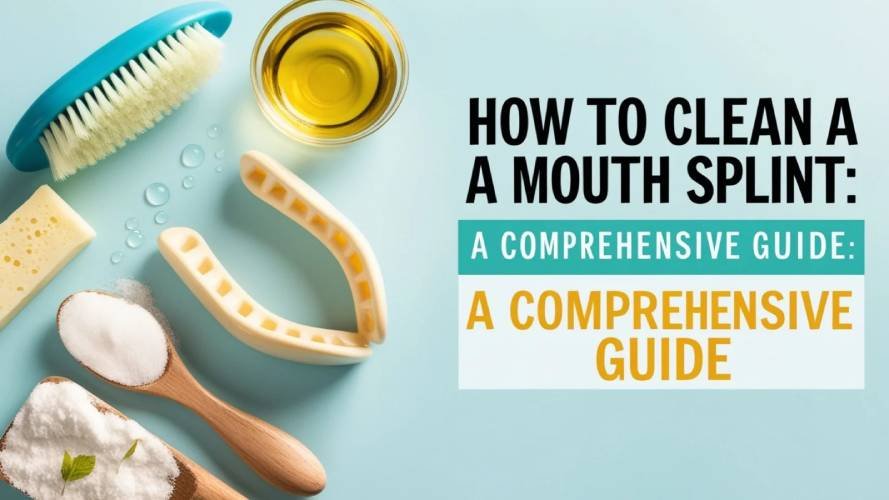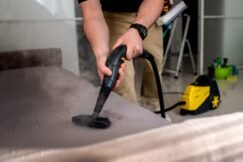What Is A Mouth Splint?
A mouth splint is a removable device designed to cover and protect teeth and gums, often worn during physical activities like sports. The main objective is preventing dental injuries during these activities or managing conditions like bruxism (teeth grinding) or temporomandibular joint disorders such as TMJ.
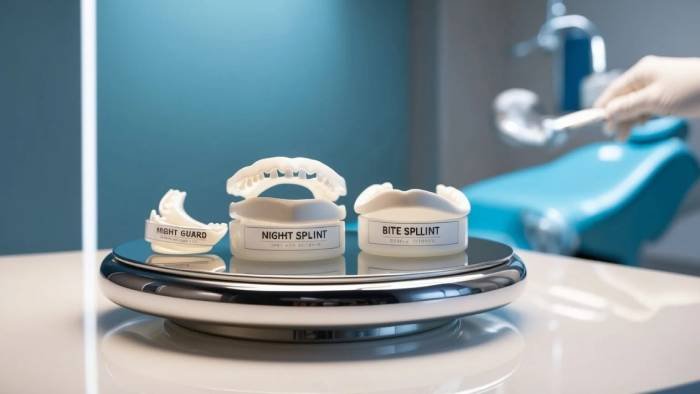
Common types include:
- Night Guards are worn during sleep to reduce teeth grinding.
- Sports Mouthguards are intended to protect teeth when participating in physical activities.
- Bite Splints: Provide assistance by aligning the jaw alignment and relieving TMJ stress.
Why Cleaning Your Mouth Splint is Essential
Maintaining the cleanliness of a mouth splint is critical for several reasons:
- Health Implications: An unclean splint may harbor bacteria that lead to infections or bad breath, with studies showing how quickly bacteria proliferate on oral devices if not cleaned on a regular basis.
- Impact on Longevity and Effectiveness: With regular cleaning comes increased longevity and effectiveness of your mouth splint. Ignoring to do so might result in wear and tear, weakening its protective capabilities over Time.
Understanding Materials
Common Materials Used in Mouth Splints
Mouth splints come in various materials with various cleaning requirements:
- Acrylic: Durable and commonly used in custom-made splints. Care must be taken when cleaning to avoid scratches.
- Plastic (thermoplastic): Commonly found in boil and bite mouthguards due to being resistant to heat; must be washed clean using cool water only for Maintenance and care.
- Silicone: Soft and flexible material used for comfort purposes. Easier to clean than other options but may discolor with improper care.
| Material | Durability | Cleaning Sensitivity |
|---|---|---|
| Acrylic | High | Moderate |
| Thermoplastic | Moderate | High (avoid hot water) |
| Silicone | Low | Low (discoloration risk) |
Preparing to Clean a Mouth Splint
Tools and Products You Will Require
Before beginning cleaning, gather these supplies:
- Recommended Cleaning Solutions: Mild cleaning soap, baking soda, or vinegar.
- Soft Bristled Brush: Ideal for lightly scrubbing with out unfavourable the fabric.
- Alternatives to Commercial Cleaners: Baking soda and vinegar can efficaciously put off stains and odors.
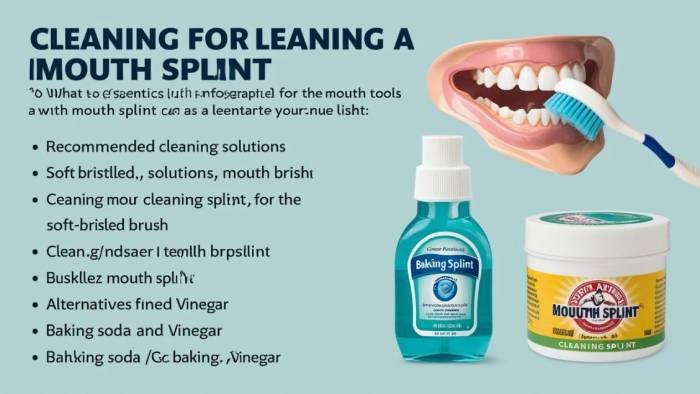
When to Clean a Mouth Splint
- Daily Maintenance: When done using the mouth splint after each use, rinse immediately afterwards in order to minimize bacteria build-up and ensure maximum hygiene.
- Deep Cleaning Schedule: Performing an in-depth cleaning once weekly is also highly recommended in order to maintain hygiene levels and promote maximum performance of this device.
Step-by-Step Cleaning Process for Carpet Cleaners
As part of your daily cleaning regimen, establish and adhere to an established daily maintenance routine.
- After Each Use: Rinsing with Cool Water is important to remove saliva and debris that has collected on the splint during usage.
- Brush the Splint: Properly by Applying some mild soap or baking soda directly onto soft-brisded toothbrush before thoroughly brushing all surfaces using soft bristled bristled brushing movement.
- Dry the Splint Thoroughly: Before storing, allow it to air dry fully to avoid bacteria growth and mold growth.
Deep Cleaning Techniques
- Soaking In Cleaning Solutions: For best results, soak splints for 15-30 minutes in equal parts water and vinegar solution for 15-30 minutes
- Remove Stubborn Stains and Odors by creating a paste use baking soda and water as scrub pads on problem areas.
- Tips to Prevent Mold and Bacteria Build-up: When drying your splint completely, store it in an open case that provides ventilation.
Specialized Cleaning Methods Available
Clearing Acrylic Mouth Splints
- Dos and Don’ts: For optimal results, utilize a soft brush instead of hard bristled ones when cleaning, avoid cleaners that contain harsh abrasive substances, and do not soak your glasses in hot water for too long.
- Suggested Products to Consider: Mild soap or denture cleaners may be effective ways of maintaining dentures.
Cleaning Thermoplastic Mouth Splints
- Specific Care Instructions: Only clean with cool water to prevent warping of your products, and avoid heat sources to preserve their aesthetic value.
- Avoid Deformation: Avoid direct sunlight or hot environments when leaving in direct sunlight for any prolonged time period.
Cleansing Silicone Mouth Splints
- Effective Cleaning Strategies: For optimal results, use soap and a soft brush; be sure to rinse it all away thoroughly after each application.
- Prevent Discoloration: Store away from direct sunlight and clean regularly to minimize discoloration.
Avoid These Common Mistakes
Using Hot Water
- Why It’s Harmful: Hot Water should never be used when working with thermoplastic splints as this will distort them and compromise fit and functionality.
- Safe Temperature Guidelines: To safely clean, always utilize cool or lukewarm water.
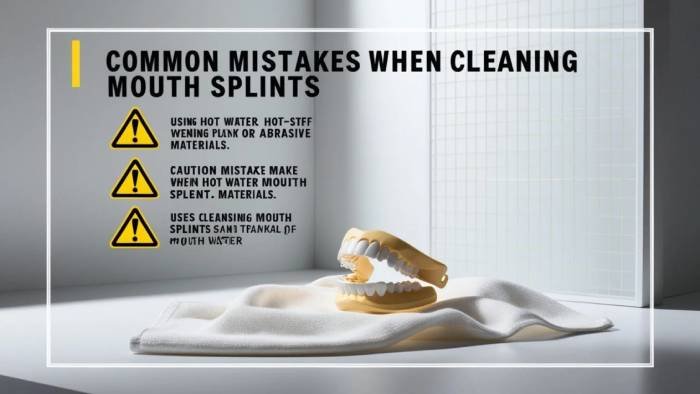
Choosing Abrasive Materials
- Potential Damages: Scratches to your splint could compromise its integrity and lead to lasting injury.
- For Gentle Alternatives: Soft brushes and nonabrasive cleaners may provide effective yet gentle options.
Skip Regular Clean-up to Save Time
- Consequences on Oral Health: Failing to floss can result in infections and bad breath.
- Establish a Routine: Set reminders to clean daily and deep clean weekly.
Also Read: How to Clean Hybrid Flooring: The Ultimate Guide 2024
Storing Mouth Splints
Proper Storage Practices
- For optimal storage conditions, place in a cool and dry location away from direct sunlight.
- Employ a Ventilated Case: Utilizing a case equipped with ventilation holes ensures airflow to prevent humidity build-up and buildup of moisture in your case.
Travel With Your Mouth SplintTM
- Solutions for Compact and Safe Storage: Select a durable travel case equipped with ventilation.
- Cleaning on the Go: For quick cleanups on the go, pack a small bottle of mild soap and a travel toothbrush.
Troubleshooting Common Issues
Bad Odors
- Causes and Solutions: Accumulation of bacteria; regular cleaning with vinegar can help.
- Preventative Measures: After each use, rinse with clean water and let air dry fully for best results.
Yellowing and Discoloration
- Pinpointing the Sources: Stains caused by food or beverage can result in discoloration.
- Effective Whitening Techniques: Soaking in baking soda solution will help restore clarity to the smile.
Visible Wear and Tear
- Repair Vs Replace Decision: If cracks or significant wear is evident, replacement should be given serious consideration.
- Extending the Lifespan of Your Splint: With proper care and storage practices in place, regular Maintenance of a splint may increase its usable life span and extend its useful life span.
Professional Cleaning Provides Value
When to Seek Professional Help
- Indices that call for professional cleaning: Persistent odors or visible stains on splint; discomfort from the use of a splint.
- What to Expect in the Process: Your dentist will examine and clean the splint carefully for signs of damage or wear and tear.
Cost and Frequency of Professional Cleaning
- Balance DIY and Professional Care: When it comes to professional care for the home, DIY cleanings should be supplemented every six-12 months by professional services such as Maid In Manhattan.
Summary
Key Takeaways for Maintaining a Clean Mouth Splint
- Maintaining good oral health and maintaining the longevity of a mouth splint is vitally important. Regular cleaning should be a priority in maintaining oral hygiene.
- Maintain a regular cleaning regime to protect against bacteria build-up and extend the lifespan of your device.
FAQs
How Often Should I Clean My Mouth Splint?
Keep the surface cleaned daily with deep cleans done twice weekly for best results.
Can Toothpaste Clean My Mouth Splint?
Yes, but only use nonabrasive toothpaste with soft bristle brushes to clean.
What Are My Options If My Mouth Splint Has Cracks?
Please reach out to a dentist as soon as possible in order to evaluate repair or replacement options.
Are You Wondering If It Is Safe To Use Denture Cleaners On Mouth Splints?
Yes, as long as they meet the material specifications for your splint.
How Can I Know If It Is Time To Change My Mouth Splint?
Telltale signs include visible wear or discomfort as well as persistent odors even after cleaning is performed.

